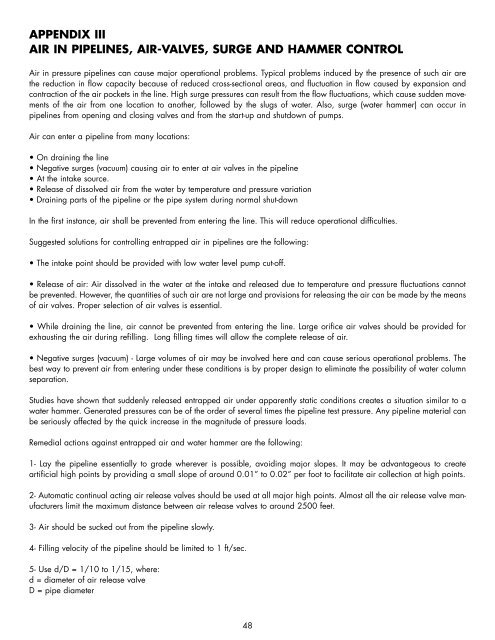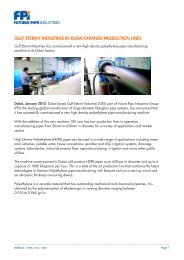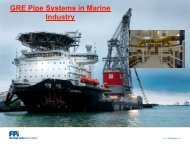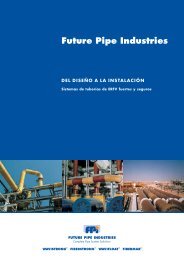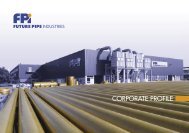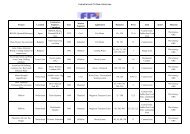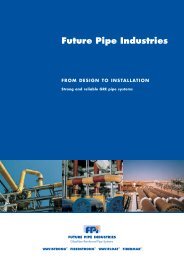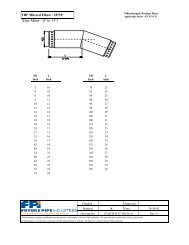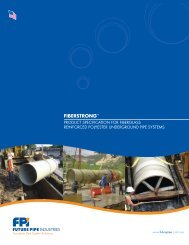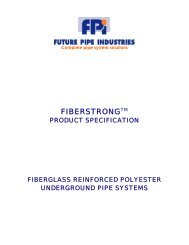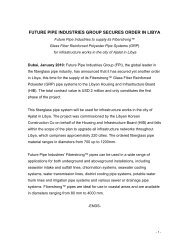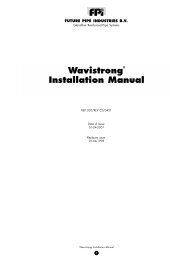Untitled - Future Pipe Industries
Untitled - Future Pipe Industries
Untitled - Future Pipe Industries
Create successful ePaper yourself
Turn your PDF publications into a flip-book with our unique Google optimized e-Paper software.
APPENDIX III<br />
AIR IN PIPELINES, AIR-VALVES, SURGE AND HAMMER CONTROL<br />
Air in pressure pipelines can cause major operational problems. Typical problems induced by the presence of such air are<br />
the reduction in flow capacity because of reduced cross-sectional areas, and fluctuation in flow caused by expansion and<br />
contraction of the air pockets in the line. High surge pressures can result from the flow fluctuations, which cause sudden movements<br />
of the air from one location to another, followed by the slugs of water. Also, surge (water hammer) can occur in<br />
pipelines from opening and closing valves and from the start-up and shutdown of pumps.<br />
Air can enter a pipeline from many locations:<br />
• On draining the line<br />
• Negative surges (vacuum) causing air to enter at air valves in the pipeline<br />
• At the intake source.<br />
• Release of dissolved air from the water by temperature and pressure variation<br />
• Draining parts of the pipeline or the pipe system during normal shut-down<br />
In the first instance, air shall be prevented from entering the line. This will reduce operational difficulties.<br />
Suggested solutions for controlling entrapped air in pipelines are the following:<br />
• The intake point should be provided with low water level pump cut-off.<br />
• Release of air: Air dissolved in the water at the intake and released due to temperature and pressure fluctuations cannot<br />
be prevented. However, the quantities of such air are not large and provisions for releasing the air can be made by the means<br />
of air valves. Proper selection of air valves is essential.<br />
• While draining the line, air cannot be prevented from entering the line. Large orifice air valves should be provided for<br />
exhausting the air during refilling. Long filling times will allow the complete release of air.<br />
• Negative surges (vacuum) - Large volumes of air may be involved here and can cause serious operational problems. The<br />
best way to prevent air from entering under these conditions is by proper design to eliminate the possibility of water column<br />
separation.<br />
Studies have shown that suddenly released entrapped air under apparently static conditions creates a situation similar to a<br />
water hammer. Generated pressures can be of the order of several times the pipeline test pressure. Any pipeline material can<br />
be seriously affected by the quick increase in the magnitude of pressure loads.<br />
Remedial actions against entrapped air and water hammer are the following:<br />
1- Lay the pipeline essentially to grade wherever is possible, avoiding major slopes. It may be advantageous to create<br />
artificial high points by providing a small slope of around 0.01” to 0.02” per foot to facilitate air collection at high points.<br />
2- Automatic continual acting air release valves should be used at all major high points. Almost all the air release valve manufacturers<br />
limit the maximum distance between air release valves to around 2500 feet.<br />
3- Air should be sucked out from the pipeline slowly.<br />
4- Filling velocity of the pipeline should be limited to 1 ft/sec.<br />
5- Use d/D = 1/10 to 1/15, where:<br />
d = diameter of air release valve<br />
D = pipe diameter<br />
48


